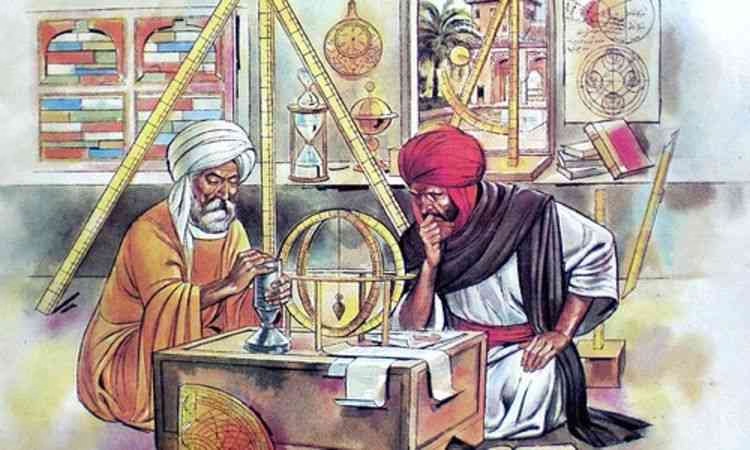Introduction
In the shadows of Europe’s Dark Ages, a brilliant light of knowledge illuminated the Islamic world. From the 8th to the 14th century, while much of Europe struggled through intellectual stagnation, the Islamic civilization experienced an extraordinary flowering of science, mathematics, medicine, and philosophy. This period, known as the Golden Age of Islamic Science, represents one of humanity’s most remarkable intellectual revolutions a time when Muslim scholars not only preserved ancient knowledge but dramatically expanded it through original discoveries and innovations.
The story of Islamic scientific contributions begins with the establishment of the Abbasid Caliphate and the founding of Baghdad in 762 CE. Under enlightened rulers like Caliph Harun al-Rashid and his son al-Ma’mun, a culture of learning flourished that transcended religious and cultural boundaries. Scholars of diverse backgrounds Muslims, Christians, Jews, and others collaborated in an unprecedented intellectual enterprise that would transform human understanding of the natural world.
What makes the Golden Age of Islamic Science particularly significant is not merely the volume of knowledge produced, but its profound impact on subsequent scientific development globally. The mathematical concepts, medical treatments, astronomical observations, and philosophical insights developed during this period laid essential foundations for the European Renaissance and the modern scientific method. Many everyday tools, techniques, and ideas we take for granted today have their origins in the workshops and libraries of medieval Baghdad, Cairo, and Cordoba.
This article explores the remarkable achievements of Islamic scholars during this golden period, examining their contributions across multiple disciplines and highlighting how their work continues to influence our world today. From the invention of algebra to revolutionary medical practices, from precise astronomical calculations to groundbreaking optical theories the legacy of Islamic science remains embedded in the very fabric of contemporary knowledge.
As we journey through this fascinating period of intellectual history, we’ll discover how Islamic civilization’s commitment to learning, observation, and experimentation created a scientific revolution that helped shape our modern world a story that deserves greater recognition in our understanding of human progress and achievement.
The House of Wisdom: Birthplace of an Intellectual Revolution

At the heart of the Islamic Golden Age stood an institution that would transform the intellectual landscape of the medieval world: the House of Wisdom (Bayt al-Hikmah). Established in Baghdad during the early 9th century by Caliph Harun al-Rashid and greatly expanded by his son al-Ma’mun, this remarkable institution served as library, translation bureau, and research center all at once.
The House of Wisdom represented something revolutionary in human history a dedicated space where scholars from diverse backgrounds could gather to translate, study, and expand upon the world’s knowledge. Within its walls, works from ancient Greece, India, Persia, and China were translated into Arabic, preserving crucial texts that might otherwise have been lost to history.
“The House of Wisdom was not just a library, but a center of innovation and creativity that produced significant advancements in various fields of knowledge,” notes historian Thomas F. Glick. This institution embodied the Islamic civilization’s commitment to learning a value deeply rooted in Islamic teachings. The Prophet Muhammad himself had encouraged the pursuit of knowledge, famously instructing followers to “seek knowledge, even unto China.”
What made the House of Wisdom particularly significant was its multicultural and multifaith character. Christian, Jewish, Muslim, and pagan scholars worked side by side, united by a common pursuit of understanding. This intellectual openness created a unique environment where ideas could cross pollinate across cultural boundaries, sparking innovations that no single tradition could have produced alone.
The translation movement centered at the House of Wisdom preserved crucial works by Aristotle, Plato, Euclid, Hippocrates, and other ancient thinkers at a time when many of these texts were neglected or lost in Europe. When these works eventually returned to Europe centuries later, translated from Arabic back into Latin, they helped fuel the Renaissance and the scientific revolution.
Beyond mere preservation, scholars at the House of Wisdom critically engaged with ancient texts, correcting errors, expanding theories, and developing entirely new fields of study. This approach building upon existing knowledge while subjecting it to empirical testing and rational critique laid important groundwork for the modern scientific method.
Mathematical Revolutions: Algebra, Algorithms, and Arabic Numerals
Perhaps no field better illustrates the transformative impact of Islamic scholarship than mathematics. The very language we use today to discuss mathematics bears the imprint of this golden age, with terms like “algebra,” “algorithm,” and “zero” all having Arabic origins.
Muhammad ibn Musa al-Khwarizmi, a Persian mathematician working in Baghdad during the 9th century, stands as one of history’s most influential mathematical minds. His groundbreaking text, “Al-Kitab al-mukhtasar fi hisab al-jabr wa’l-muqabala” (The Compendious Book on Calculation by Completion and Balancing), established algebra as a distinct mathematical discipline. The word “algebra” itself derives from “al-jabr” in his title.

Al-Khwarizmi’s work represented a significant conceptual leap. Rather than focusing on specific numerical problems, he developed general methods for solving equations introducing the revolutionary concept of using letters to represent unknown quantities. His systematic approach to solving quadratic equations remains fundamental to mathematics education today. Additionally, his name gave us the term “algorithm,” reflecting his development of step-by-step procedures for solving mathematical problems.
Another revolutionary contribution came with the introduction and refinement of the Hindu-Arabic numeral system, including the crucial concept of zero as a placeholder and number in its own right. This decimal system, which replaced the cumbersome Roman numerals used in Europe, made complex calculations vastly more efficient and accessible. The spread of this numeral system throughout the Islamic world and eventually to Europe fundamentally transformed commerce, science, and everyday life.
Other mathematical luminaries of this period included:
- Omar Khayyam, better known in the West as a poet, who developed methods for solving cubic equations geometrically and made important advances in the development of non-Euclidean geometry.
- Abu al-Wafa’ al-Buzjani, who made significant contributions to trigonometry, including creating the first table of sines and tangents.
- Sharaf al-Din al-Tusi, who developed the concept of the mathematical function and pioneered algebraic and numerical solutions to cubic equations.
These mathematical innovations weren’t merely abstract intellectual exercises. They found practical applications in astronomy, engineering, commerce, and architecture throughout the Islamic world. The intricate geometric patterns adorning mosques and palaces from the Alhambra in Spain to the Blue Mosque in Istanbul stand as beautiful testaments to the sophisticated mathematical understanding developed during this period.
Astronomy and the Mapping of the Heavens
Islamic astronomers made remarkable advances in understanding the cosmos, creating more accurate models of celestial movements than their predecessors and developing sophisticated instruments for observation. Their work was driven both by practical needs determining prayer times and directions, creating accurate calendars and by a deep philosophical curiosity about the structure of the universe.

Al-Battani (known in Latin as Albategnius) stands among the most significant astronomers of the Islamic Golden Age. Working in the late 9th and early 10th centuries, he calculated the solar year with remarkable precision 365 days, 5 hours, 46 minutes, and 24 seconds, which is only minutes off from modern measurements. His catalog of star positions corrected many errors in Ptolemy’s earlier work and remained a standard reference for centuries.
Al-Farghani (Alfraganus) produced his influential “Elements of Astronomy,” which synthesized existing knowledge while making original contributions. This text was translated into Latin and used as a standard astronomy textbook in European universities well into the 17th century. His accurate calculation of the Earth’s circumference demonstrated the empirical precision characteristic of Islamic astronomy.
The astrolabe, though invented earlier, was perfected by Islamic astronomers and became the most important astronomical instrument until the invention of the telescope. This sophisticated device allowed for the determination of time, measurement of celestial positions, and navigation. The intricate brass astrolabes produced throughout the Islamic world represent not only scientific tools but also works of remarkable artistic craftsmanship.
Islamic observatories, particularly the famous Maragheh Observatory established in the 13th century and later the Samarkand Observatory, were the most advanced astronomical research facilities of their time. These institutions, often supported by royal patronage, allowed for collaborative research and systematic observation on an unprecedented scale.
The astronomical tables (zij) produced by Islamic astronomers provided accurate data on planetary positions, eclipses, and other celestial phenomena. The Toledan Tables, developed in Islamic Spain, and later the Ilkhanic Tables, created under the direction of Nasir al-Din al-Tusi, were used throughout Europe and the Islamic world for centuries.
Perhaps most significantly, several Islamic astronomers began to question the Ptolemaic geocentric model of the universe. Ibn al-Shatir developed a model that eliminated the problematic equant point in Ptolemy’s system, creating a mathematically elegant alternative that maintained geocentrism while addressing its inconsistencies. Later scholarship has revealed striking similarities between his model and Copernicus’s work, suggesting possible influence.
Medicine and Pharmacology: Pioneers of Modern Healthcare
Islamic medicine represented one of the most advanced and sophisticated medical traditions in the pre-modern world. Building upon Greek, Indian, and Persian foundations, Muslim physicians developed new treatments, surgical techniques, and medical theories that would influence healthcare for centuries.
Ibn Sina (Avicenna), perhaps the most renowned physician of the Islamic Golden Age, produced his monumental “Canon of Medicine” in the early 11th century. This comprehensive medical encyclopedia systematized all existing medical knowledge and added Ibn Sina’s own observations and treatments. Translated into Latin, it became the standard medical textbook in European universities until the 17th century. Ibn Sina’s emphasis on empirical observation and his detailed descriptions of numerous diseases including the first clear description of meningitis established new standards for medical literature.

Al-Razi (Rhazes), working a century earlier, made equally significant contributions. His clinical approach to medicine emphasized careful observation and the importance of case histories. He was among the first to use controlled clinical trials, famously testing different treatments for patients with meningitis and documenting the outcomes. Al-Razi also wrote the first treatise on smallpox and measles, accurately distinguishing between these diseases for the first time.
Surgical techniques advanced significantly during this period. Al-Zahrawi (Albucasis) produced his influential “Al-Tasrif,” a 30-volume medical encyclopedia that included detailed descriptions of surgical procedures and illustrations of over 200 surgical instruments, many of which he designed himself. His work established surgery as a respected medical specialty and introduced techniques that would be used for centuries.
The understanding of human anatomy also progressed. Ibn al-Nafis made the revolutionary discovery of pulmonary circulation in the 13th century, correctly describing how blood travels from the heart to the lungs and back contradicting Galen’s long-accepted theory. This discovery, though not widely recognized in Europe until centuries later, represents one of the most important advances in understanding human physiology before William Harvey’s work on circulation.
Islamic hospitals (bimaristans) were among the most sophisticated healthcare institutions of their time. Unlike the primarily religious hospices of medieval Europe, these were secular institutions with specialized wards, pharmacies, libraries, and lecture halls. The Adudi Hospital in Baghdad and the Mansuri Hospital in Cairo were renowned centers of medical treatment and education, where physicians received practical training alongside theoretical instruction.
Pharmacology flourished as a distinct discipline during this period. Al-Biruni and Ibn al-Baytar produced comprehensive pharmacopoeias describing thousands of drugs derived from plants, animals, and minerals. These works included detailed information on preparation methods, dosages, and therapeutic effects. Many drugs first described in these texts, from camphor to senna, remain in use today.
Optics and the Science of Vision
The study of optics understanding the nature of light and vision underwent a revolutionary transformation during the Islamic Golden Age, largely through the work of one extraordinary scholar: Ibn al-Haytham (Alhazen).
Born in Basra in 965 CE, Ibn al-Haytham conducted his groundbreaking research in Cairo, where he wrote his masterpiece, “Kitab al-Manazir” (Book of Optics). This comprehensive seven volume work, completed around 1027, fundamentally challenged the prevailing theories of vision that had dominated since antiquity.

Greek thinkers like Euclid and Ptolemy had proposed “emission theories” suggesting that vision occurred when rays emanated from the eyes to perceive objects. Ibn al-Haytham decisively rejected this view, correctly arguing that vision results from light reflecting off objects and entering the eyes. This seemingly simple insight represented a paradigm shift in understanding vision.
Through careful experimentation using dark chambers (the ancestors of modern cameras), Ibn al-Haytham studied how light travels in straight lines, how it reflects off surfaces at equal angles, and how it refracts when passing between different media. His detailed analysis of the eye’s anatomy led him to understand its functioning as an optical system, with the lens focusing light onto the sensitive surface at the back of the eye.
Beyond these fundamental discoveries, Ibn al-Haytham made important contributions to understanding atmospheric refraction (explaining why the sun and moon appear larger near the horizon), the rainbow, and various optical illusions. He also conducted experiments with curved mirrors and lenses, laying groundwork for future developments in telescopes and microscopes.
When translated into Latin in the late 12th century as “De Aspectibus” or “Perspectiva,” Ibn al-Haytham’s work profoundly influenced European scholars including Roger Bacon, Johannes Kepler, and René Desca in straight lines and how it is refracted and reflected by different surfaces. His meticulous experiments with lenses, mirrors, and the behavior of light rays laid the foundations of modern optics and the scientific method itself.
He was among the first to emphasize the importance of empirical observation and repeatable experiments, stating that theories must be tested by evidence a core principle of modern science. His insistence on hypothesis, experimentation, and verification positioned him as a true pioneer of scientific inquiry.
The impact of Ibn al-Haytham’s work extended far beyond the Islamic world. His Book of Optics was translated into Latin in the 12th century and profoundly influenced European scholars such as Roger Bacon, Johannes Kepler, and even Leonardo da Vinci. It remained a dominant reference in the field of optics for several centuries.
Conclusion
The Golden Age of Islamic Science was more than just a historical flourish of intellect it was a transformative era that reshaped humanity’s understanding of the world. Through rigorous study, translation, and original thought, Muslim scholars preserved and expanded upon the knowledge of earlier civilizations and ignited a scientific legacy that continues to inform modern disciplines.
From the algebraic principles of al-Khwarizmi to the surgical innovations of al-Zahrawi, from the astronomical precision of al-Battani to the optical revelations of Ibn al-Haytham, the achievements of this era were not isolated triumphs but part of a collective civilization wide commitment to knowledge, inquiry, and truth.

In recognizing and celebrating this period, we not only honor the scholars who propelled the march of human progress but also remind ourselves that the pursuit of knowledge transcends time, culture, and creed. The story of Islamic science is, ultimately, a story of human curiosity and its boundless potential to change the world.
🧠 Hungry for more forgotten truths?
Dive deeper into the untold stories that shaped our world.
Explore Curialo. Feed your curiosity.
Related Articles
- Islam: A Clear Guide to the World’s Fastest Growing Religion
- The Lost Library of Baghdad: The House of Wisdom and Its Untold Legacy
- The Woman Who Founded the World’s First University
🔍 Browse More Articles | 💬 Join the Conversation on Facebook




